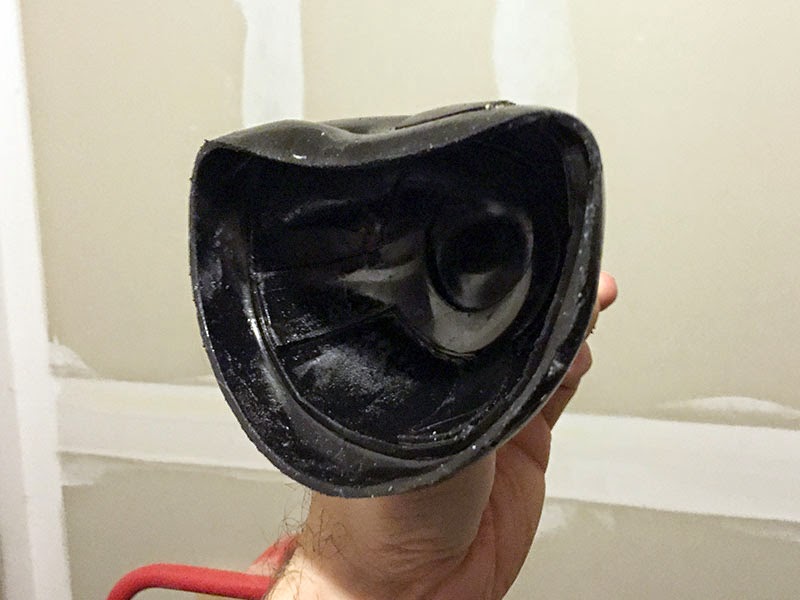 I got my Polytek A70 rubber in the mail, and set to work on recasting the plunger. This stuff is so much different than the A30! It's still a two-parts-in-equal-measure substance, but the pour time is only five minutes (as opposed to 30), and the demolding time is only an hour (instead of 18 hours)!
I got my Polytek A70 rubber in the mail, and set to work on recasting the plunger. This stuff is so much different than the A30! It's still a two-parts-in-equal-measure substance, but the pour time is only five minutes (as opposed to 30), and the demolding time is only an hour (instead of 18 hours)! Once the first one had been released from the mold, I turned around and made five more that day. I've got six plungers in all, and a whole lot more of the stuff left! I'm debating on using it all, and that would net me about—at rough guess—18 plungers or so, since
Once the first one had been released from the mold, I turned around and made five more that day. I've got six plungers in all, and a whole lot more of the stuff left! I'm debating on using it all, and that would net me about—at rough guess—18 plungers or so, since I've only gone through about a third of the two bottles.
(I've since discovered that two of them have one small air bubble each in the cup portion, but they're hardly noticeable, and I will probably just cover them with a few permanent marker penstrokes.)
In the meantime, the A30 plunger has all but fallen completely apart. Poor thing.

Then I set to work on my second attempt at the dome cowl. I had again pre-cut my fiberglass pieces for the first layer (to make sure all the angles were shape to mitigate air bubbles), and then planned on using surfacing veil for the second layer, and thicker ripped-up chop mat for the third and potential fourth layer.
 I got out the dome cowl mold and washed it. Having neglected to add the name tag indentation on my first attempt with the cowl, I corrected that this time. I took an old plastic convention entry badge (PAX, for those who are curious), cut two 7.5cm x 3cm rectangles out of it, and cementing them together with carpet adhesive, clamped for a nice amount of time. Then, I sprayed a lesser-grade adhesive (the one I used for the rubber dome inserts) onto one side, let that get tacky, and clamped it onto the cowl mold for about an hour.
I got out the dome cowl mold and washed it. Having neglected to add the name tag indentation on my first attempt with the cowl, I corrected that this time. I took an old plastic convention entry badge (PAX, for those who are curious), cut two 7.5cm x 3cm rectangles out of it, and cementing them together with carpet adhesive, clamped for a nice amount of time. Then, I sprayed a lesser-grade adhesive (the one I used for the rubber dome inserts) onto one side, let that get tacky, and clamped it onto the cowl mold for about an hour. I coated the mold with a sponged-on layer of PVA (left to dry), and then a few passes of silicone release agent spray. No wax this time. My leftover can of gel-coat had set in its tin since the time I had last cast a cowl, so I needed to go get another one, grumble, mutter.
I coated the mold with a sponged-on layer of PVA (left to dry), and then a few passes of silicone release agent spray. No wax this time. My leftover can of gel-coat had set in its tin since the time I had last cast a cowl, so I needed to go get another one, grumble, mutter.With the fresh tin in hand, I stirred it all up so that it wasn't all settled and separated. Then I poured myself five ounces or so in a separate pot, added the catalyst, and stirred, stirred, stirred. I sponged all that on (with about an ounce left over), and let it sit for two hours with the heater on in the garage.
 Once it was mostly dry, I placed the pre-cut pieces into position and mixed up about four ounces of resin. Once those pieces were in place, I added a layer of surfacing veil glass over the top, ensuring that I had taken care of any visible air bubbles. I took about an hour break, and then tackled the next layers of chop mat, mixing up six more ounces of resin for that.
Once it was mostly dry, I placed the pre-cut pieces into position and mixed up about four ounces of resin. Once those pieces were in place, I added a layer of surfacing veil glass over the top, ensuring that I had taken care of any visible air bubbles. I took about an hour break, and then tackled the next layers of chop mat, mixing up six more ounces of resin for that. All in all, I think this one will turn out much better than the first. I'm still going to need to do a lot of repair work on it to smooth it all out due to the rough, ripply texture of the mold, but hey, that's what Bondo and sandpaper are for.
All in all, I think this one will turn out much better than the first. I'm still going to need to do a lot of repair work on it to smooth it all out due to the rough, ripply texture of the mold, but hey, that's what Bondo and sandpaper are for.I'll get this Dalek done if it kills me! (Or rather, unless it kills me!)









































